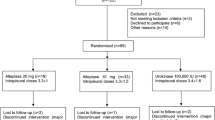Abstract
Expansion of the lung is necessary for successful pleurodesis therapy in patients with malignant pleural effusion (MPE). However, this is often impossible in multiloculated MPEs. The aim of this study was to investigate the effect of the fibrinolytic agent, streptokinase, on pleurodesis therapy used in the management of multiloculated MPE. Forty patients with multiloculated MPEs were randomly assigned to two groups: fibrinolytic and control. In the fibrinolytic group, 250,000 IU of streptokinase in 50 ml saline was applied into the pleural space at 24–36–48–60 h after opening a tube thoracostomy. In the control group, the same procedure was carried out using only 50 ml saline solution. Both groups were compared based on the following: (1) volume of pleural drainage at 24–48, 48–72, and 24–72 h, (2) chest computer tomography images before and after therapy, (3) dyspnea symptoms after therapy, and (4) recurrence rate. The mean drainage volumes for the fibrinolytic and control groups were 493 and 248 cc at 24–48 h, 446 and 198 cc at 48–72 h, and 939 and 446 cc at 24–72 h (P < 0.001). Comparison of the two groups by computer tomography revealed that 17 patients (85 %) in the fibrinolytic group had greater than 40 % improvement, whereas only 7 patients (35 %) in the control group had the same degree of improvement (P = 0.001). The dyspnea symptoms disappeared in 90 % of the patients in the fibrinolytic group and in 55 % of the patients in the control group (P = 0.03). Recurrence rate was 11 % in fibrinolytic group and 45 % in control group (P = 0.07). Streptokinase is a reliable treatment option in obtaining effective pleural drainage and increasing lung expansion in patients with multiloculated MPE.
Access this article
We’re sorry, something doesn't seem to be working properly.
Please try refreshing the page. If that doesn't work, please contact support so we can address the problem.


Similar content being viewed by others
References
Lombardi G, Zustovich F, Nicoletto MO, Donach M, Artioli G, et al. Diagnosis and treatment of malignant pleural effusion: a systemic literature review and new approaches. Am J Clin Oncol. 2010;33:420–3.
American Thoracic Society. Management of malignant pleural effusions. Am J Respir Crit Care Med. 2000;162:1987–2001.
Pien GW, Gant MJ, Washam CL, Sterman DH. Use of implantable pleural catheter for trapped lung syndrome in patients with malignant pleural effusion. Chest. 2001;119:1641–6.
Okur E, Baysungur V, Tezel C, Ergene G, Okur HK, et al. Streptokinase for malignant pleural effusions: a randomized controlled study. Asian Cardiovasc Thorac Ann. 2011;19:238–43.
Sahn SA. Use of fibrinolytic agents in the management of complicated parapneumonic effusions and empyemas. Thorax. 1998;53:65–72.
Krishnan S, Amin N, Dozar AJ, Stringel G. Urokinase in the management of complicated parapneumonic effusions in children. Chest. 1997;112:1579–83.
Diacon AH, Theron J, Schuurmans MM, Van de Wal BW, Bolliger CT. Intrapleural streptokinase for empyema and complicated parapneumonic effusions. Am J Respir Crit Care Med. 2004;170:49–53.
Hsu LH, Soong TC, Feng AC, Liu MC. Intrapleural urokinase for the treatment of loculated malignant pleural effusions and trapped lungs in medically inoperable cancer patients. J Thorac Oncol. 2006;1:460–7.
Marder VJ, Sherry S. Thrombolytic therapy: current status (1). N Engl Med. 1988;318:1512–20.
Davies CW, Traill ZC, Gleeson FV, Davies RJ. Intrapleural streptokinase in the management of malignant multiloculated pleural effusions. Chest. 1999;115:729–33.
Gilkeson RC, Silverman P, Haaga JR. Using urokinase to treat malignant pleural effusions. Am J Roentgenol. 1999;173:781–3.
Parulekar W, Di Primio G, Matzinger F, Dennie C, Bociek G. Use of small-bore vs large bore chest tubes for treatment of malignant pleural effusions. Chest. 2001;120:19–25.
Caglayan B, Torun B, Turan D, Fidan A, Gemici C, et al. Efficacy of iodopovidone pleurodesis and comparison of small-bore versus large-bore chest tube. Ann Surg Oncol. 2008;15:2594–9.
Conflict of interest
The authors declare no conflict of interest.
Author information
Authors and Affiliations
Corresponding author
Rights and permissions
About this article
Cite this article
Saydam, O., Karapinar, K., Gokce, M. et al. The palliative treatment with intrapleural streptokinase in patients with multiloculated malignant pleural effusion: a double-blind, placebo-controlled, randomized study. Med Oncol 32, 179 (2015). https://doi.org/10.1007/s12032-015-0612-0
Received:
Accepted:
Published:
DOI: https://doi.org/10.1007/s12032-015-0612-0




